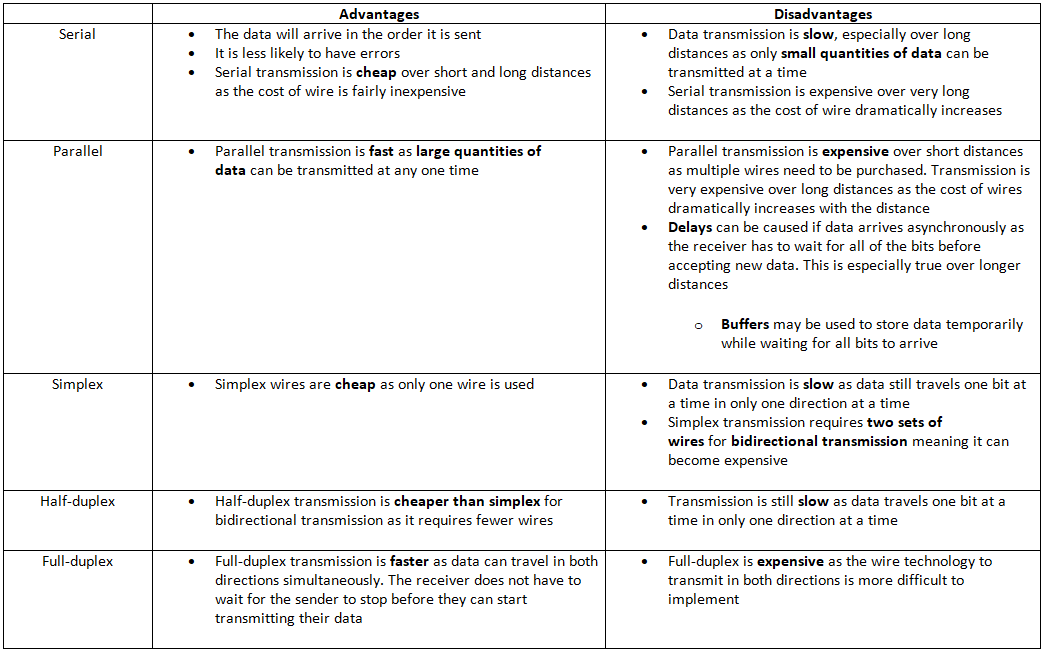Class 10 Exam > Class 10 Notes > Computer for GCSE/IGCSE > Data Transmission
Data Transmission | Computer for GCSE/IGCSE - Class 10 PDF Download
Wired connections
Wires can be
- Serial: One bit is sent at a time across a single wire

- Parallel
- Multiple bits are sent concurrently across multiple wires during parallel transmission.
- Asynchronous transmission may result in varying arrival times for different bits, causing skewing or skewed data.
- This transmission method does not guarantee that all data will arrive simultaneously.

Types of Data Transmission
- Simplex: Simplex transmissions are unidirectional, traveling in only one direction.
- Half-duplex: These transmissions are bidirectional, meaning they can travel in both directions, but not simultaneously.
- Full-duplex: In full-duplex transmissions, signals can be transmitted in both directions at the same time.
Wires can be combinations of serial, parallel, simplex, half-duplex, and full-duplex transmission types. Figure 3: Wire types can be combined between serial/parallel and simplex/half-duplex/full-duplex
Figure 3: Wire types can be combined between serial/parallel and simplex/half-duplex/full-duplex
Wire Types in Data Transmission
- Serial-Simplex: Data is transmitted one bit at a time in a single direction on one wire.
- Serial-Half-duplex: Data can be transmitted in both directions on a single wire, but only one bit at a time can be transmitted in one direction at a time.
- Serial-Full-duplex: Data can be transmitted in both directions at the same time on a single wire, one bit at a time.
- Parallel-Simplex: Multiple wires transmit one bit at a time in one direction.
- Parallel-Half-duplex: Multiple wires send multiple bits of data in both directions, but only one direction at a time.
- Parallel-Full-duplex: Multiple wires send multiple bits of data in both directions at the same time.
Advantages and disadvantages of each method

Understanding Data Transmission Methods
- Serial Data Transmission
- Connecting an external hard drive to a computer
- Transmitting data over a telephone line
- Parallel Data Transmission
- Transmitting data from a computer to a printer using a multi-wire connector
- Simplex Data Transmission
- Transmitting data from a computer to a printer without requiring data back from the printer
- Modern devices like printers may send acknowledgement signals, possibly needing half-duplex connections
- Half-Duplex Communication
- Instances where only one party can speak at a time, like in phone conversations
- Example: A walkie-talkie with a push-to-speak button
- Full-Duplex Communication
- Simultaneous two-way communication where both parties can speak and listen at the same time
- Example: Broadband internet connections for downloading and uploading data
Question for Data TransmissionTry yourself: Which type of data transmission allows for simultaneous communication in both directions?View Solution
The document Data Transmission | Computer for GCSE/IGCSE - Class 10 is a part of the Class 10 Course Computer for GCSE/IGCSE.
All you need of Class 10 at this link: Class 10
|
99 docs|31 tests
|
FAQs on Data Transmission - Computer for GCSE/IGCSE - Class 10
| 1. What are the advantages of using wired connections for data transmission? |  |
Ans. Wired connections offer faster and more reliable data transmission compared to wireless connections. They are also more secure as the data is not as easily intercepted. Additionally, wired connections typically have lower latency, making them ideal for activities requiring real-time data transmission.
| 2. Can wired connections be used for long-distance data transmission? |  |
Ans. Yes, wired connections can be used for long-distance data transmission by utilizing technologies such as fiber optics. Fiber optic cables can transmit data over long distances without significant loss of signal strength, making them suitable for applications requiring data transmission over vast areas.
| 3. What types of cables are commonly used for wired data transmission? |  |
Ans. Common types of cables used for wired data transmission include Ethernet cables, coaxial cables, and fiber optic cables. Ethernet cables are commonly used for local area network (LAN) connections, while coaxial cables are often used for cable television and internet connections. Fiber optic cables are preferred for long-distance and high-speed data transmission.
| 4. Is it possible to combine wired and wireless connections for data transmission? |  |
Ans. Yes, it is possible to combine wired and wireless connections for data transmission through technologies such as Wi-Fi extenders or powerline adapters. These devices allow users to extend the reach of their wired connections wirelessly, providing flexibility in setting up networks in different environments.
| 5. How do wired connections compare to wireless connections in terms of data security? |  |
Ans. Wired connections are generally more secure than wireless connections as the data transmitted through cables is less vulnerable to interception. Wireless signals can be intercepted by unauthorized users, whereas wired connections require physical access to the cable in order to compromise the data transmission.
Related Searches















